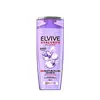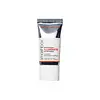What's inside
What's inside
 Key Ingredients
Key Ingredients

 Benefits
Benefits

 Concerns
Concerns

 Ingredients Side-by-side
Ingredients Side-by-side

Water
Skin ConditioningSodium Laureth Sulfate
CleansingSodium Lauryl Sulfate
CleansingCocamidopropyl Betaine
CleansingSodium Chloride
MaskingGlycol Distearate
EmollientHexylene Glycol
EmulsifyingParfum
MaskingCocamide Mea
EmulsifyingCitric Acid
BufferingSodium Benzoate
MaskingSodium Hydroxide
BufferingDimethicone
EmollientCarbomer
Emulsion StabilisingCoco-Betaine
CleansingSalicylic Acid
MaskingGuar Hydroxypropyltrimonium Chloride
Skin ConditioningAmodimethicone
Trideceth-10
CleansingPEG-100 Stearate
Steareth-6
EmulsifyingSodium Hyaluronate
HumectantPhenoxyethanol
PreservativeLimonene
PerfumingTrideceth-3
EmulsifyingFumaric Acid
BufferingAcetic Acid
BufferingCI 60730
Cosmetic ColorantCI 60725
Cosmetic ColorantWater, Sodium Laureth Sulfate, Sodium Lauryl Sulfate, Cocamidopropyl Betaine, Sodium Chloride, Glycol Distearate, Hexylene Glycol, Parfum, Cocamide Mea, Citric Acid, Sodium Benzoate, Sodium Hydroxide, Dimethicone, Carbomer, Coco-Betaine, Salicylic Acid, Guar Hydroxypropyltrimonium Chloride, Amodimethicone, Trideceth-10, PEG-100 Stearate, Steareth-6, Sodium Hyaluronate, Phenoxyethanol, Limonene, Trideceth-3, Fumaric Acid, Acetic Acid, CI 60730, CI 60725
Water
Skin ConditioningC12-20 Acid PEG-8 Ester
EmulsifyingCaprylic/Capric Triglyceride
MaskingCoco-Caprylate/Caprate
EmollientGlycerin
HumectantButylene Glycol
HumectantCetyl Ricinoleate
EmollientCetyl Alcohol
EmollientAscorbyl Glucoside
AntioxidantSaccharum Officinarum Extract
MoisturisingAlgae Extract
EmollientPassiflora Edulis Seed Oil
EmollientRosa Hybrid Flower Extract
Skin ConditioningLycium Chinense Fruit Extract
AntioxidantVaccinium Macrocarpon Fruit Extract
AstringentVaccinium Angustifolium Fruit Extract
Skin ProtectingTocopheryl Acetate
AntioxidantNiacinamide
SmoothingSqualane
EmollientSodium Hyaluronate
HumectantHydroxyethyl Urea
HumectantCaffeine
Skin ConditioningHordeum Vulgare Extract
EmollientTriticum Vulgare Germ Extract
Skin ConditioningLactobacillus Ferment
Skin ConditioningSodium Polyaspartate
HumectantTrehalose
HumectantSorbitol
HumectantHydrolyzed Yeast Protein
Skin ConditioningYeast Extract
Skin ConditioningIsopropyl Isostearate
EmollientPEG-100 Stearate
PPG-15 Stearyl Ether
EmollientCaprylyl Glycol
EmollientHydrogenated Polydecene
EmollientLaureth-8
EmulsifyingCarbomer
Emulsion StabilisingSodium Acrylate/Sodium Acryloyldimethyl Taurate Copolymer
Emulsion StabilisingSilica
AbrasiveSynthetic Fluorphlogopite
Xanthan Gum
EmulsifyingDimethicone
EmollientTriethoxycaprylylsilane
Pentylene Glycol
Skin ConditioningTin Oxide
AbrasiveSodium Hydroxide
BufferingCitric Acid
BufferingSodium Citrate
BufferingDisodium EDTA
BHT
AntioxidantPotassium Sorbate
PreservativeSodium Benzoate
MaskingPhenoxyethanol
PreservativeMica
Cosmetic ColorantCI 77891
Cosmetic ColorantCI 77491
Cosmetic ColorantWater, C12-20 Acid PEG-8 Ester, Caprylic/Capric Triglyceride, Coco-Caprylate/Caprate, Glycerin, Butylene Glycol, Cetyl Ricinoleate, Cetyl Alcohol, Ascorbyl Glucoside, Saccharum Officinarum Extract, Algae Extract, Passiflora Edulis Seed Oil, Rosa Hybrid Flower Extract, Lycium Chinense Fruit Extract, Vaccinium Macrocarpon Fruit Extract, Vaccinium Angustifolium Fruit Extract, Tocopheryl Acetate, Niacinamide, Squalane, Sodium Hyaluronate, Hydroxyethyl Urea, Caffeine, Hordeum Vulgare Extract, Triticum Vulgare Germ Extract, Lactobacillus Ferment, Sodium Polyaspartate, Trehalose, Sorbitol, Hydrolyzed Yeast Protein, Yeast Extract, Isopropyl Isostearate, PEG-100 Stearate, PPG-15 Stearyl Ether, Caprylyl Glycol, Hydrogenated Polydecene, Laureth-8, Carbomer, Sodium Acrylate/Sodium Acryloyldimethyl Taurate Copolymer, Silica, Synthetic Fluorphlogopite, Xanthan Gum, Dimethicone, Triethoxycaprylylsilane, Pentylene Glycol, Tin Oxide, Sodium Hydroxide, Citric Acid, Sodium Citrate, Disodium EDTA, BHT, Potassium Sorbate, Sodium Benzoate, Phenoxyethanol, Mica, CI 77891, CI 77491
 Reviews
Reviews

Ingredients Explained
These ingredients are found in both products.
Ingredients higher up in an ingredient list are typically present in a larger amount.
Carbomer is a polymer of acrylic acid. Its main role is to create a gel consistency.
A high amount of carbomer can cause pilling or balling up of products. Don't worry, most products contain 1% or less of carbomer.
Citric Acid is an alpha hydroxy acid (AHA) naturally found in citrus fruits like oranges, lemons, and limes.
Like other AHAs, citric acid can exfoliate skin by breaking down the bonds that hold dead skin cells together. This helps reveal smoother and brighter skin underneath.
However, this exfoliating effect only happens at high concentrations (20%) which can be hard to find in cosmetic products.
Due to this, citric acid is usually included in small amounts as a pH adjuster. This helps keep products slightly more acidic and compatible with skin's natural pH.
In skincare formulas, citric acid can:
While it can provide some skin benefits, research shows lactic acid and glycolic acid are generally more effective and less irritating exfoliants.
Most citric acid used in skincare today is made by fermenting sugars (usually from molasses). This synthetic version is identical to the natural citrus form but easier to stabilize and use in formulations.
Read more about some other popular AHA's here:
Learn more about Citric AcidDimethicone is a type of synthetic silicone created from natural materials such as quartz.
What it does:
Dimethicone comes in different viscosities:
Depending on the viscosity, dimethicone has different properties.
Ingredients lists don't always show which type is used, so we recommend reaching out to the brand if you have questions about the viscosity.
This ingredient is unlikely to cause irritation because it does not get absorbed into skin. However, people with silicone allergies should be careful about using this ingredient.
Note: Dimethicone may contribute to pilling. This is because it is not oil or water soluble, so pilling may occur when layered with products. When mixed with heavy oils in a formula, the outcome is also quite greasy.
Learn more about DimethiconePeg-100 Stearate is an emollient and emulsifier. As an emollient, it helps keep skin soft by trapping moisture in. On the other hand, emulsifiers help prevent oil and water from separating in a product.
PEGS are a hydrophilic polyether compound . There are 100 ethylene oxide monomers in Peg-100 Stearate. Peg-100 Stearate is polyethylene glycol ester of stearic acid.
Phenoxyethanol is a preservative that has germicide, antimicrobial, and aromatic properties. Studies show that phenoxyethanol can prevent microbial growth. By itself, it has a scent that is similar to that of a rose.
It's often used in formulations along with Caprylyl Glycol to preserve the shelf life of products.
Sodium Benzoate is a preservative. It's used in both cosmetic and food products to inhibit the growth of mold and bacteria. It is typically produced synthetically.
Both the US FDA and EU Health Committee have approved the use of sodium benzoate. In the US, levels of 0.1% (of the total product) are allowed.
Sodium benzoate works as a preservative by inhibiting the growth of bacteria inside of cells. It prevents the cell from fermenting a type of sugar using an enzyme called phosphofructokinase.
It is the salt of benzoic acid. Foods containing sodium benzoate include soda, salad dressings, condiments, fruit juices, wines, and snack foods.
Studies for using ascorbic acid and sodium benzoate in cosmetics are lacking, especially in skincare routines with multiple steps.
We always recommend speaking with a professional, such as a dermatologist, if you have any concerns.
Learn more about Sodium BenzoateSodium Hyaluronate is hyaluronic acid's salt form. It is commonly derived from the sodium salt of hyaluronic acid.
Like hyaluronic acid, it is great at holding water and acts as a humectant. This makes it a great skin hydrating ingredient.
Sodium Hyaluronate is naturally occurring in our bodies and is mostly found in eye fluid and joints.
These are some other common types of Hyaluronic Acid:
Learn more about Sodium HyaluronateSodium Hydroxide is also known as lye or caustic soda. It is used to adjust the pH of products; many ingredients require a specific pH to be effective.
In small amounts, sodium hydroxide is considered safe to use. However, large amounts may cause chemical burns due to its high alkaline.
Your skin has a natural pH and acid mantle. This acid mantle helps prevent harmful bacteria from breaking through. The acid mantle also helps keep your skin hydrated.
"Alkaline" refers to a high pH level. A low pH level would be considered acidic.
Learn more about Sodium HydroxideWater. It's the most common cosmetic ingredient of all. You'll usually see it at the top of ingredient lists, meaning that it makes up the largest part of the product.
So why is it so popular? Water most often acts as a solvent - this means that it helps dissolve other ingredients into the formulation.
You'll also recognize water as that liquid we all need to stay alive. If you see this, drink a glass of water. Stay hydrated!
Learn more about Water